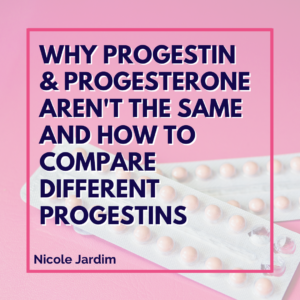Last week I went to the Integrative Healthcare Symposium, a 5-day health and wellness extravaganza held once a year in New York City. It’s a chance for anyone to hear the best doctors in integrative and holistic health present the latest research on functional medicine.
I was particularly interested in the pre-conference workshop, “Hormone testing and balancing” (duh lol) and as you can imagine, I learned a ton! Like whoa! It got me thinking about the myths surrounding our feminine health and how they are continually perpetuated by the conventional medical industry because of it’s lack of viable solutions for women’s reproductive and menstrual health conditions. Something I take major issue with because I continually hear the most outrageous stories from women who have been messed about by what I call the “take a drug and brush it under the rug” phenomenon.

So I decided to ask women what their biggest questions and concerns are around their periods, menstrual health and reproduction. I then put on my detective hat and got to work on busting those myths.
Here are my top five for this week…
1. Do I need to see egg-white-like cervical fluid in order to be fertile (ovulating)? We don’t all have the same cervical fluid patterns right?
Technically no, you do not have to see egg-white-like cervical fluid. What you need to be on the lookout for is cervical fluid with a very wet consistency and cold feel. What you’re really looking for is a pattern from dry –> wet, with the wettest cervical fluid being the most fertile.
And no, we do not all have the same cervical fluid patterns. Here’s the one you see the most: None -> Sticky -> Creamy -> Eggwhite -> Watery -> Creamy/Sticky -> None. If yours doesn’t look like this it doesn’t mean you are not ovulating! The whole egg-white cervical fluid pattern is just what is seen in the majority of women, but not all women. Phew, now you can breathe! 🙂
2. My doctor’s solution for all my menstrual woes is the birth control pill. Is this the only way to regulate my cycle?
Absolutely not. The pill does nothing more than mask a deeper underlying hormonal imbalance and the longer you stay on it, the longer you will be able to ignore this imbalance. Trust me, this is probably the worst thing you could do for yourself. There is a reason for periods that are all over the place, heavy periods, painful periods, or no periods at all, and the pill ain’t gonna fix it. What will fix it however, is getting rid of the dangerous synthetic hormones and getting back to the way your body was mean’t to function.
Unfortunately mainstream docs don’t have training in functional nutrition, targeted supplementation, botanicals and effective stress reduction techniques so it’s difficult for them to recommend anything other than the pill or surgery. Use your judgement – if your gut instinct is telling you this isn’t right, then go with that and start to explore other options. If you don’t have the vaguest idea where to start, then check out my Fix Your Period Home Study E-Course. It’s a really great place to begin!
3. When charting my cycle using the fertility awareness method, what is considered my peak day?
Your peak day is your most fertile day. It is the very last day you see fertile-quality cervical fluid before going to sticky or dry after ovulation. This fluid could be watery or egg-white but generally should just be a very wet consistency. The peak day is NOT the day you have the most cervical fluid (of any kind) or the day you ovulate.
4. Is it possible for our bodies to ovulate and the temps don’t show it assuming we are temping correctly? I have had multiple cycles where I do everything right and have all the signs of ovulation including tons of cm but the temps don’t show a big enough jump for ovulation. I have heard everything from it has to be at least a half degree jump to it has to be only .2 or. 3 jump. What’s the truth?
This is a great question! First of all, I want to break down what “everything correctly” actually means. Are you:
- Taking your temp at the same time or as close to the same time every day
- Taking your temp as soon as you wake up before doing anything else at all including getting out of bed
- Taking your temp after at least 3 consecutive hours of sleep
- Accounting for any kind of illness, episodes of stress, and travel – travel across time zones messes with your temps
- Using a good thermometer? Sometimes a regular digital thermometer isn’t good enough. I recommend the iBasal thermometer because it is super accurate down to hundredths of a degree.
- Checking to see if your temperature rose at least 2/10ths (0.2) of a degree above your pre-ovulatory temperatures and stayed within that higher range for more than 3 days?
If you are following all those steps and still not seeing a typical thermal shift then it could mean two things:
- Your corpus luteum is not producing enough progesterone for you to see the shift
- You have an underlying thyroid issue -hypothyroid or under-active thyroid function – that is causing your temperatures to stay low.
You would then want to get your progesterone levels checked to see if you have low progesterone and also have your thyroid levels checked as your thyroid has a huge impact on fertility. Please see my post on thyroid testing for guidelines. Don’t get too disheartened, there are reports of women who don’t see shifts but have gotten pregnant but you want to make sure your hormones are in tip-top shape regardless.
5. If I got my period, then I must have ovulated right?
Yes and no. Basically, if you ovulated then it will be followed by a true period somewhere between 12-16 days after ovulation (ideally). A true period is defined as red blood flow that lasts from 3-5 days (sometimes longer), but preferably closer to five days, and has a continuous flow. You can learn more in this post I wrote – What a Period is Supposed to Look Like.
Here’s the other scenario: You can also bleed when your hormones drop. This will happen when your body senses that there is no pregnancy and sends a signal for your uterine lining to start shedding – the signal comes in the form of a drop in progesterone. So you have a hormonal bleed, but not an actual period. These bleeds tend to be lighter and don’t flow as much. Check out the post I just mentioned for what this actually looks like.



7 thoughts on “Menstrual Q&A: Cervical fluid, birth control, cycle tracking and more…”
There are a lot of incredible questions on here, but it’s so much easier to get clear answers in our Know Your Flow Facebook group. Just paste the following link into your browser:http://tinyurl.com/pkflo6r
There are tons of women in there who’ve had similar experiences and it’s much more private. I also have a free Period Survival Guide for you here: http://tinyurl.com/nh7y55g
I want to know if I had not my period for 4 months now but I had sex in November last year and I thought I was pregnant,but not during that month I had hot and cold for about two and then it stop,do I my underlying thyroid issues or low progesterone.
Thanks lady loves, I’ll be posting Part 2 tomorrow! 🙂
Is low progesterone always connected to something going on with the thyroid? I always have a clear temp rise but due to other signals in my cycle my doctor is havering my estrogen, Progesterone, and TSH checked. I got the sense that he added on the TSH test just to be sure and it’s more connected to the corpus luteum not producing enough progesterone. Could you clarify, would that be connected to thyroid stuff or could it stand on its own. Wondering if I need to contact him and push for the T3, T4, and reverse T3 tests if it doesn’t necessarily seem to be a thyroid issue.
How can I lengthen my follicular phase? Thanks.
In myth buster #5 in the above post, you mentioned that a true period would have a continuous flow. What does it mean when your period lasts about 5-6 days, yet the flow is not continuous the entire time?
For women with PCOS (like me), with longer cycles (mine is about 50 days), who do have a temperature shift at the end, but with frequent fluxuations in temperature throughout the cycle, is there a way to tell when you are ovulating or about to ovulate (or if we are ovulating at all)? I think I can tell after the fact because I get a temperature shift, but I’m just not sure.